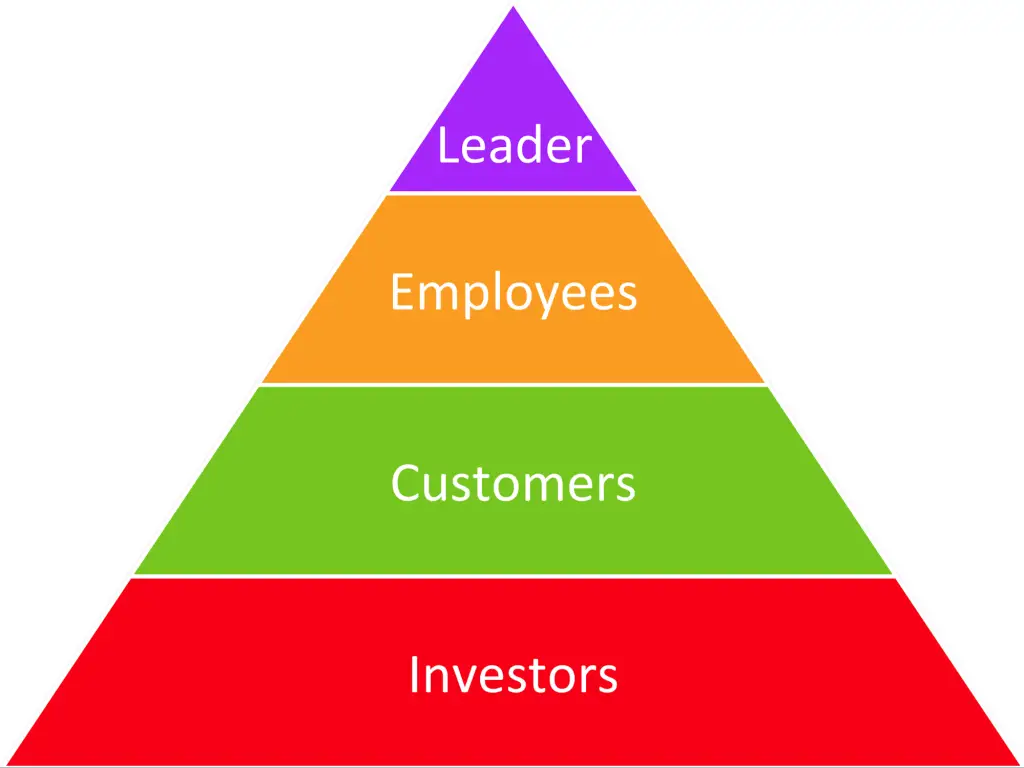The other day, our team received a congratulatory email from Dave, our manager, for completing a crucial project. A little later, John, who had worked on tough assignments for the project, thanked Dave for praising his efforts. He was delighted for not being forgotten, even after a couple of months of leaving the organization.
I was pleasantly surprised to know that my leader carried his relationship with his employees with such grace.
Dave was a true servant leader. He was genuinely interested in the welfare of his employees, often inquired about our well being, and ensured we reach our career objectives, even if this means we may move on. With his serving attitude, he always got the best out of us.
Let’s discuss the servant leadership style to know how leaders like Dave operate and bring success to an organization.
What is servant leadership?
Leadership, for some people, is all about enforcing power. Whatever the issue, they believe sheer strength and brute force can solve it.
These leaders stay at the top in an organization to accumulate power and follow the traditional leadership pyramid model, as explained in the following figure.
As can be seen, the leader is right at the top in such a model, followed by employees, customers, and investors.

Servant leaders, on the other hand, have a serve-first attitude. These leaders help people develop and perform to the best of their abilities. They achieve this by putting the needs of others first. Unlike traditional leaders, they do not try and accumulate power. On the contrary, they share it with other people.
As a result, they turn the traditional leadership model completely upside down. This model puts leaders at the bottom of the hierarchy and others, i.e., employees, customers, and investors at the top. Here is what the servant leadership model looks like:

Although servant leadership is a universal concept, it was Robert K. Greenleaf, who coined the term in his essay that he published in 1970.
According to him, servant leadership starts with the natural feeling that one wants to serve first; then, conscious choice brings one to aspire to lead. And finally, the best test of servant leadership style is to check if those whom you serve grow as an individual.
To understand servant leadership better, let’s have a look at the attributes of a servant leader.
The characteristics of a servant leader
According to Larry C. Spears, President, and CEO at the Greenleaf Center for Servant-Leadership, Regent University, there are ten basic characteristics of servant-leader.
Let’s discuss them one by one.
Listening:
As a servant leader, you follow two-way communication. You not only communicate by saying, but by listening to others as well. When you listen, you can find out the areas of concern, and also the suggestions that can help with better results.
Listening ability also allows you to understand the desires and aspirations of the people around you. As a result, you are able to make better decisions in the interest of your team.
Empathy:
You need to be able to connect to people and understand their feelings to be a servant-leader. When you can relate to the circumstances of others, you can handle them better. Empathy also helps you understand the challenges faced by the stakeholders in your business.
Worried that people may not reciprocate? Here’s why they will:
You genuinely care for people and try and solve their problems by being empathetic. As a result, people endorse and support your ideas and align themselves to attain the objectives you set.

Healing:
Everyone, including you, goes through rough patches. However, you are expected to deliver accurate results all the time. Hence, you need to have the power to repair the damage caused by poor performances. To achieve this, traditional leaders rely on punishments and penalties.
However, as a servant-leader, you lift the spirits of employees. You understand that a poor show is no one’s choice, and instead of pressurizing, you start healing.
And then, magic happens!
Like therapy relieves the pain of wounds; similarly, healing amends the emotional state of people. As a result, they work with greater zeal and enthusiasm to achieve desired goals.
Awareness:
You need to be aware of yourself and the needs of others to be a servant-leader. When you are self-aware you gain clarity on the issues of ethics and values. You also gain an understanding of how these apply to the situation you are in.
Awareness of others’ needs gives you a holistic view. In case of a problem, you can examine all aspects before you attempt to solve it.

Persuasion:
“Persuasion can take many forms, but the result is still the same – a willing partnership designed to accomplish a shared vision of purpose” – Dr. Ed Rough in Leadership is Persuasion).
As a servant-leader, you convince people, rather than coerce them, to follow a particular path. You use persuasion, not your authority, to motivate people to take action. You do not dominate people and throw orders at them, but inspire and build trust. You arrive at decisions with consensus.
Conceptualization:
As a servant-leader, you need to hit the balance between the vision of your organization and the day-to-day operations. Traditional leaders are fixated only on immediate goals; however, you need to shift focus to involve the bigger picture to use the power of conceptualization.
Find it hard to implement? Here’s a quick tip:
You need to think beyond numbers and the operational grinds of the tasks in hand. This can involve helping your team with tools and training that they’ll use not only immediately, but also in the longer run.
Foresight:
To be a servant-leader, you should have the capacity to predict the results of your decisions before you make them. Foresight is your ability to learn lessons from your past and take steps in the present that prevents undesired outcomes for the future.
The skill of having foresight has a lot to do with your intuitive mind. However, remember that intuition is a mix of experience and common sense.
Have a look at this video to understand how foresight helps Jeff Cohen, CMO Seller Labs, develop better customer products & solutions.
Stewardship:
Peter Block, the author of Stewardship, defines a steward as ‘someone who holds something in trust for another.’
As a servant-leader, you need to get out of the ‘hit the targets at any cost’ mentality and adapt to a steward’s mentality, i.e., you need to think beyond personal achievements and rewards for the bigger cause.
How do you go about bringing this change in your attitude? Here’s a suggestion:
Make sure every decision you take has something for your employees, customers, investors, and all stakeholders; they should prosper with the service you offer. Do not take decisions that benefit only yourself.
Commitment to the growth of others:
If you want to hit the sweet spot in your journey as a servant-leader, THIS IS IT – you need to get passionately involved in the growth of other people. You should not keep the best opportunities for yourself, allow others to grab them too.
Remember, the most important resource that you work with is people. You need to overcome the fear that they will move on or outshine you. Instead, practice commitment for their growth- take suggestions before making decisions, give them training opportunities for growth, promote them for better roles.
Building a Community:

To be a servant-leader, you need to understand the importance of communities in shaping humans; the way they positively influence lives. Hence, you have to build a community within your organization.
Build a community! Do you think it will have no impact on your company? Not really, it can actually change the fortunes of your business. Here’s how:
Your employees can easily feel detached and focus on individual goals. When you inspire them to take the goals of others and organization into account, you form a community. As a result, genuine lasting bonds develop.
Now, you are aware of the characteristics of a servant-leader. The next step is to apply these to your business. The following are a few methods you can use.
How to apply servant leadership in your organization?
Do you believe the servant leadership model will work best only in non-profit organizations or humanitarian institutes? Think again!
According to a study by Roger William University, servant leadership is effective in a competitive, for-profit, service organization.

Following are a few practical methods you can use to develop servant leadership in your company :
Change the mindset :

You cannot apply servant leadership unless you have the right mindset. You need to have a ‘serve-first’ attitude rather than ‘lead-first’ to be a servant-leader.
You serve your staff, which in turn serves and benefits your organization. Need an example to understand better?
Southwest airlines’ leadership is a classic case of the servant-leadership model. Founder Herb Kelleher’s philosophy of putting employees first, helped Southwest create employee-friendly policies.
The outcome?
A highly engaged workforce with low turnover resulted in 35 plus consecutive years of profit – quite a feat – in the turbulent airline industry.
How do you build a people-first mindset in your organization? Following are a few tips:
- Develop a cultural department that evolves the policy of ‘everyone matters.’ This department can form committees to solve employee and client issues.
- Arrange for regular one-to-one private counseling sessions with your employees. Such forums encourage open discussions and help in identifying their needs.
- Appreciate people for their work and commitment through monetary benefits. Make sure awards and appreciation recognize every piece of great work.
- Celebrate anniversaries of clients, investors and stakeholders, and birthdays of employees. Organize family gatherings of your staff. Such events help in building a healthy workplace environment.
Ensure availability of resources:
You need to make sure that everyone has the tools and knowledge they need to meet their objectives. Without the necessary resources, your team will not be able to complete their assignments efficiently and accurately. You have to identify the challenges and roadblocks your employees are facing.
Wondering how are you going to find out the areas where people need assistance? Here are a couple of methods that can be useful :
As a servant-leader, you need to figure out ways to help people open up on the issues they are facing. One-on-one meetings are a great tool to let your team have an open discussion on the bottlenecks. Such meetings are also useful in resolving conflicts and interpersonal issues.

Traditional leaders, at times, expect one employee to do the work of two. However, to be a servant-leader, you need to hit the ‘appropriate workload balance’ culture in your organization. Include a new team member if there are tight deadlines, and employees are finding it hard to meet them.
While it’s important to be there for your employees, hit the right balance between providing them the essential resources, and making them think about solutions themselves.
If you are always there to help your employees, some of them may stop solving problems on their own. Hence, don’t avoid making tough decisions or giving negative feedback when this is needed.
Offer opportunities for personal development :
You need to take care of your employees beyond their jobs to be a successful servant-leader. If you restrict yourself only to the professional aspects, your staff is bound to work only for personal goals. However, if you provide opportunities for personal growth, they will align themselves with organizational objectives.
How can you help employees in their personal development?
Having a learning and development support department exhibits career growth assistance for your employees. You can include mentoring programs, training sessions, guest speakers, and external certifications as support functions in this department. This upskills your employees and upgrades your company to the latest requirements of businesses.
Do not restrict yourself to just work-related offerings as opportunities for personal development. How about running a program to lose weight? Or a policy on providing interest-free loans to your employees for personal needs?
These, and many such employee-centric policies, may not meet any immediate corporate needs, but leads to higher employee engagement and trust, and fosters stronger relationships with team members and other stakeholders.
A healthy work environment, built by an authentic interest in the personal development of employees, can upscale customer satisfaction levels as well. As a result, service ratings and customer loyalty increases, which can improve the credibility of your organization’s brand.
Final thoughts:
With a lot of successful stories of servant leadership in the corporate set-up, there is no reason why you cannot apply it in your organization.
However, make sure you analyze your situation before you apply the servant leadership model. For instance, consider applying servant-leadership alongside styles like transformational leadership, where you develop an inspiring vision of the future and motivate people to deliver it.
Also, keep in mind that servant leadership requires time to achieve positive results. Hence, if your organization is going through a financial crisis or there are other reasons why you need a quick turnaround, this leadership style should not be used. You need to be swift and decisive in such a case.
No matter what goals you have, as a leader, you need to consider servant-leadership as a compelling option for delivering results.
How are you going to apply servant leadership in your organization? Have you exhibited any of the servant leadership qualities in your business? Let us know in the comments below.